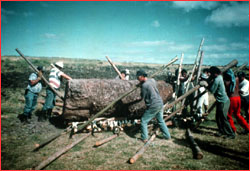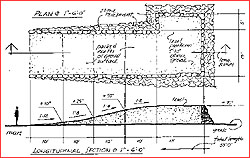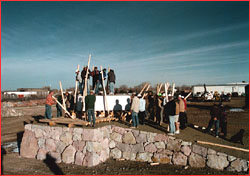 |
 |
Vince Lee's Uphill Battle Part 2 | Back to Part 1 A Hasty Experiment Having arrived at this solution, I made a small model to illustrate the idea and suggested we try a full-scale test to see if it would actually work. NOVA agreed, and using some skinny leftover poles and a roll of small diameter cord, we hastily tied up a sled and two ladders with which to try moving a "three-ton" rock promised by a local supplier. Due to a shortage of material, we ended up with about half as many sliders and sled crossbars as my design called for, but I figured it wouldn't matter with such a small load. The rock finally arrived about 10 a.m. the final day of the shoot, weighing at least six tons and looking like a gigantic Idaho spud. Next to it, our sled and ladders seemed woefully flimsy and inadequate. The "crane" we expected for getting it off the truck and onto our sled turned out to be a two-ton swing arm hoist mounted on the truck; it proved all but useless. Instead, we rolled the boulder off the truck, shattering the truck bed's edge planks in the process, and watched our "moai" thud ominously into a shallow ditch. Just getting the boulder out of the ditch and onto the sled was a huge project. We levered it up onto one of its "edges" and then rolled it onto our sled, simulating a moai in the prone position. The sled lay visibly crushed under the load, with one runner cracked and both pressed tightly into the mud of the ditch bottom with no sliders underneath. As the camera rolled, we began levering the grossly overloaded tangle of poles up out of the ditch and onto the first ladder, prying between the projecting crossbars on the sled and the ground.
One observer watching our struggle said, "Look at it. It's a mess!" I had to agree, but for one thing: It worked. My 12-man crew had levered a six-ton rock about 15 feet in an hour and a half. Each man had moved about 1,000 pounds of rock with no help at all from pullers. If we'd done everything right, our performance would have been much more impressive, but even as it was, our rate of progress (say 80-100 feet per day) was about the same as the previous methods tested in the NOVA film with four to six times as many people. Once underway, their sled moved much faster than ours, of course, but they lost many hours re-rigging their gear between moves. Slow as our progress was, we could nevertheless have gotten our "moai" up onto its ahu without anyone working on the platform's seaward side. But could our method move an 80-ton moai, about the largest ever moved by the Rapanui (see How Big Were They?). The problem is partly simple arithmetic. If each of the 40 or so pullers hired by NOVA to pull the replica moai exerted 100 pounds of force to move their sled, the friction coefficient (the ratio of the weight of a load versus the force needed to drag it) using sliders over rails must have been about .2 (4,000 pounds of force divided by 20,000 pounds of moai and sled weight = .2). Applying this coefficient to an 80-ton load requires 16 tons of forward force or 320 pullers at 100 pounds per person. My levermen were each moving about 1,000 pounds of load, which would cut this workforce in half (80 tons = 160,000 pounds / 1000 = 160 levermen). But how many men would it take if levers were used properly, correcting all the problems we encountered during our hurried test of the idea? There was only one way to find out.
On December 15th, 1998, my friend Bruce Davis and I collaborated on a full-scale trial at his masonry contracting yard in Brighton, Colorado. We named our test the Sisyphus Project after the King of Corinth whom, in Greek mythology, the lord of the underworld condemned to an eternal afterlife of futilely pushing a large stone up a hill. I had commissioned Mark Younghein, a log-cabin contractor in Longmont, Colorado, to fabricate a 10x15-foot sled and four 5x10-foot ladder sections from stout lodgepole pine logs. The sled weighed about a ton and the ladders were in four 500-pound sections for ease of carrying. The designs were otherwise similar to those shown in Figure 1, except that the sliders and sled crossbars were let several inches into the tops of the rails and runners, respectively, to achieve tight, rigid joints. This turned out to be an important detail. Any play in these joints greatly reduces the effectiveness of the levers, since part of each throw is wasted taking up the slack. Finally, we provided both long and short levers about three inches thick for people working atop the load and on the sled, respectively (see Figure 2). Meanwhile, Davis's crew had constructed a scaled-down replica of the steepest ramp still existing on Easter Island (see Figure 4), a daunting 1:4 or 25 percent slope. His team also assembled several large blocks of white marble from which to select a load, depending on how many people turned out to help move it.
The project we set for ourselves was simple: move the rock up the ramp and rotate it at least 90 degrees with levers alone, using no more than the working surface of the ramp for the purpose. After a nervous first effort that turned out to be serious overkill, we cut the crew back to see how few people could move the sled on level ground. Eight long levers handled from atop the rock was all it took. Each person had a mechanical advantage of about seven, imparting about 700 pounds of forward force—a total of 5,600 pounds for the group. Their combined weight and that of the sled added about 3,500 pounds to the 13-ton block, so the coefficient of friction must have been about .19 (5,600 / 29,500 = .1898).
It is not known where the Rapanui rotated their moai, but to cover the worst-case possibility we decided to do it atop the ramp, in the most constricted location of all. We easily accomplished the maneuver as shown in Figure 3, except that by levering both sides ahead, the outside of the turn more than the inside, we needed no pullers for forward movement onto the turned ladder. So levers alone carried the day, and it took only about two hours to climb the 55-foot ramp and make the turn at the top. An Open Question However feasible the scheme described here may be, we have no direct evidence that the Rapanui or anyone else in ancient times used it. Nevertheless, it is clear that the hundreds of people needed to drag the largest moai on Easter Island could not possibly have pulled them all the way up onto any of the numerous seacoast ahu there. They must have used some other, much more efficient transport method. The simple levering system proposed here is the only idea thus far proven to solve this problem, and it would have worked for the Rapanui and anyone else in antiquity faced with moving big rocks up steep hills and into small places. Did the ancient Rapanui do it this way? We may never know. But we now know a method they could have used, which is more than we knew before. Vincent R. Lee is owner of Design Associates, Architects in Jackson Hole, Wyoming and a research associate both in Andean Studies at Berkeley and with the Museum of Man in San Diego. He has led numerous field expeditions and mapping projects in Latin America as well as various studies in pre-Columbian architectural design and construction techniques, particularly those involving megalithic masonry. Images: (2,3,6,6) Courtesy of Vincent Lee Vince Lee's Uphill Battle | NOVA Moves a Megalith | How Big Were They? Move the Moai | Explore Easter Island | Secrets of Easter Island | Resources | Transcript Medieval Siege | Pharaoh's Obelisk | Easter Island | Roman Bath | China Bridge | Site Map Editor's Picks | Previous Sites | Join Us/E-mail | TV/Web Schedule About NOVA | Teachers | Site Map | Shop | Jobs | Search | To print PBS Online | NOVA Online | WGBH © | Updated November 2000 |
 On Easter Island, Vince Lee's team tries to lever a six-ton stone block on a hastily made sled.
On Easter Island, Vince Lee's team tries to lever a six-ton stone block on a hastily made sled.
 Figure 4: Plan and cross-section of the Sisyphus ramp.
Figure 4: Plan and cross-section of the Sisyphus ramp. Volunteers on the Sisyphus Project begin to rotate the 13-ton block atop the ramp.
Volunteers on the Sisyphus Project begin to rotate the 13-ton block atop the ramp.
 Unlike Sisyphus, Vince Lee got what he wanted: A large block levered up a steep ramp with few people in a short period of time.
Unlike Sisyphus, Vince Lee got what he wanted: A large block levered up a steep ramp with few people in a short period of time.